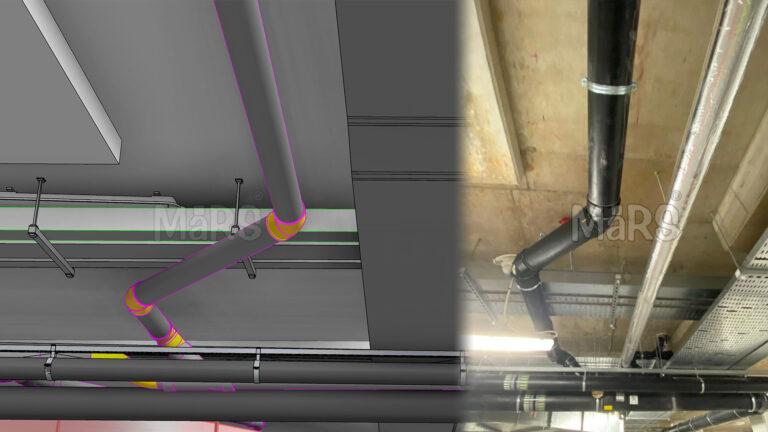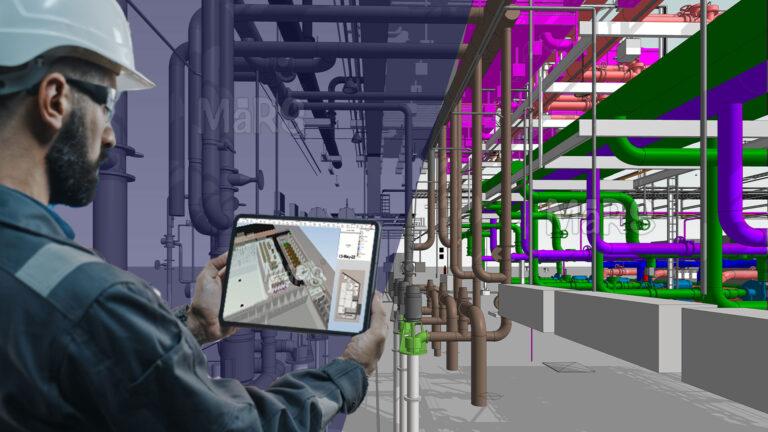Building Information Modeling (BIM) is a game-changer for MEP (Mechanical, Electrical, and Plumbing) contractors. This technology allows contractors to create accurate 3D models of building systems, improving planning, coordination, and execution. BIM helps MEP contractors streamline workflows, reduce errors, and collaborate more effectively with other stakeholders like architects and engineers.
By using BIM, contractors can spot issues early, avoid costly mistakes, and save time and money. It also enables better system integration, precise documentation, and more efficient material management. BIM ultimately enhances the quality of the project and ensures smoother construction processes.
Benefits of BIM for MEP Contractors
MEP BIM services provide significant advantages for contractors. They create accurate models showing how systems fit together, reducing mistakes during construction. Studies show that MEP contractors using BIM report an average 25% reduction in rework and a 10% decrease in labor costs.
BIM improves MEP Coordination Services by managing how different systems work together. With MEP Shop Drawings Services, contractors can create precise, ready-made drawings that make workflows smoother and more accurate.
Improved Collaboration
BIM lets architects, engineers, and contractors work together on one digital platform. MEP Shop Drawings Services add clear, detailed plans that reduce confusion during construction. This proactive approach saves time and costs by preventing costly changes during the build phase.
Enhanced Coordination
MEP Coordination Services ensure mechanical, electrical, and plumbing systems work together smoothly in a building. BIM allows contractors to visualize these systems in 3D, ensuring seamless integration. Using BIM with MEP Shop Drawings helps contractors create accurate layouts that fit design and construction needs, reducing mistakes and saving money.
Better Design Accuracy
BIM tools provide precise details about materials, dimensions, and placement. For MEP contractors, this accuracy leads to fewer mistakes on-site and better adherence to project specifications. Detailed 3D models ensure that designs meet client expectations.
Advanced Clash Detection
BIM software helps find clashes, like ducts crossing electrical conduits, in real time. It fixes these issues in the digital model before construction starts, saving time and money.
Comprehensive Quantity Takeoffs
BIM provides accurate quantity takeoffs, helping MEP contractors estimate costs better. This detail helps with efficient procurement and reduces material waste, keeping the budget on track.
Cost and Time Savings
BIM helps spot issues in the design phase, reducing changes during construction. This results in significant cost savings. Additionally, BIM shortens project timelines by streamlining workflows and improving communication.
Improved Facility Management
The benefits of BIM extend beyond construction. MEP contractors can give facility managers detailed models for easier maintenance and upgrades. These models serve as a comprehensive guide for the building’s lifecycle.
Sustainability
BIM supports energy-efficient designs by analyzing building systems and optimizing performance. MEP contractors can use this data to design sustainable solutions that follow current green building standards.
Streamlined Prefabrication
BIM enables MEP contractors to design systems with prefabrication in mind. Accurate models allow off-site fabrication, boosting quality control and cutting installation time on-site.
Enhanced Documentation
BIM keeps all project documents, like drawings, schedules, and specs, in one place. This helps MEP contractors access the latest info, reducing miscommunication and mistakes.
Data-Driven Decision Making
BIM incorporates data analysis tools that help contractors optimize system performance. For example, MEP contractors can simulate HVAC systems to find the most energy-efficient setups.
Improved Safety
BIM enhances safety planning by simulating construction sequences and identifying potential hazards. Contractors can use these insights to improve safety and meet industry standards. BIM is more than just a tool; it’s a necessity for MEP contractors aiming to deliver high-quality projects. From better collaboration to cost savings and sustainability, the advantages are undeniable. Using MEP BIM Services and MEP Coordination Services helps contractors stay competitive and succeed in today’s construction industry.
Conclusion
BIM offers a multitude of benefits for MEP contractors, from better collaboration and improved design accuracy to significant cost and time savings. It allows contractors to work more efficiently, reduce errors, and ensure the seamless integration of systems. By adopting BIM, MEP contractors can stay ahead of the competition, improve project outcomes, and deliver high-quality, sustainable buildings.









